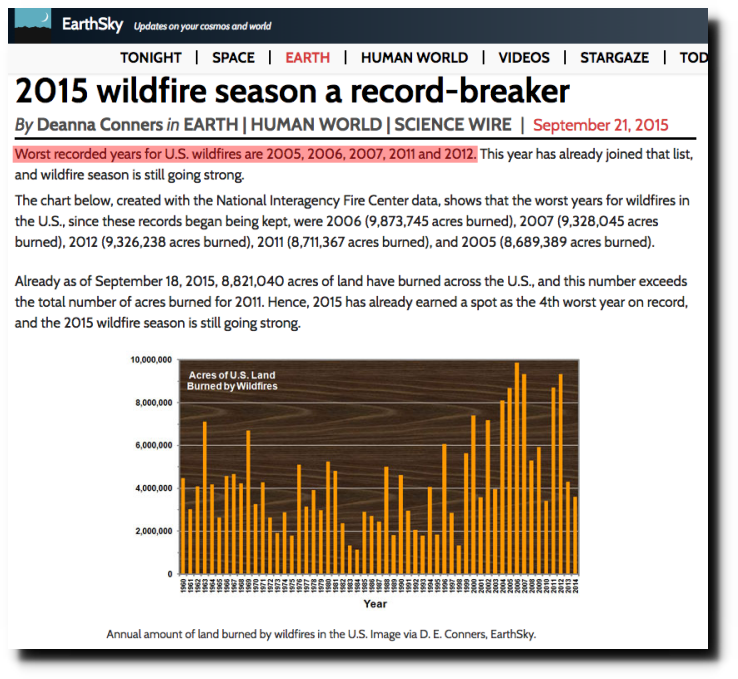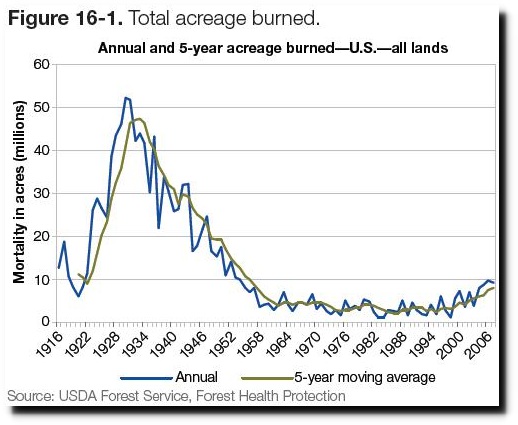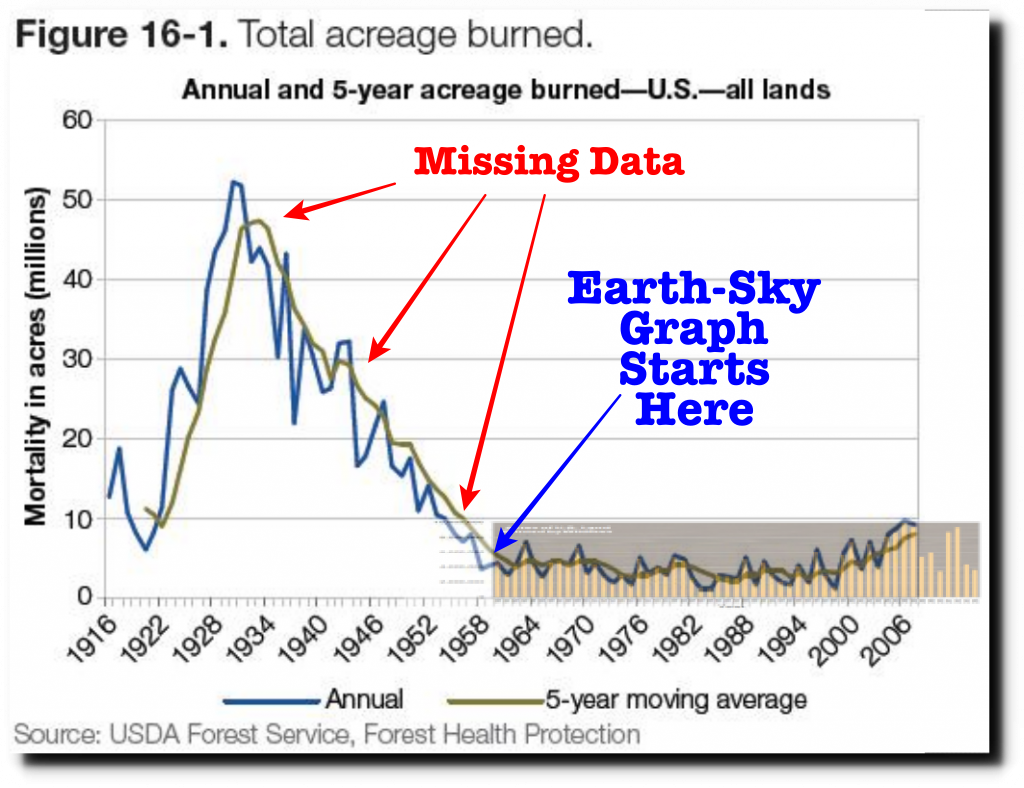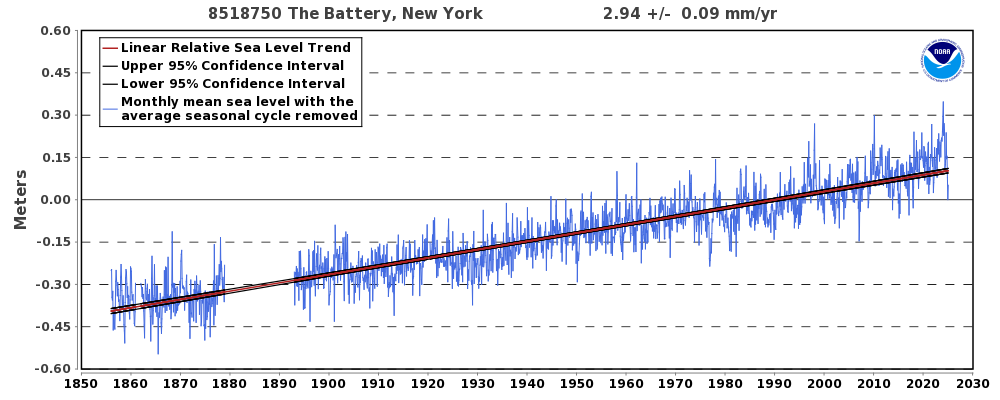How to lie with graphs
According to climate alarmists at Earth-Sky, wildfires are on the increase in the US, and 2005, 2006, 2007, 2011 and 2012 were record years.

2015 wildfire season a record-breaker | Earth | EarthSky
The graph above starts in 1960, and it isn’t hard to see why. Their graph starts at one of the lowest years on record. The graph below is a much longer record from the US Forest Service.

Indicator 3.16: Area and percent of forest affected by abiotic agents
I overlaid the two graphs at the same scale below, showing the spectacular fraud behind the start date of 1960 in the 1960-2014 graph. Their record high years were actually closer to being record low years.

The USFS graph is quite real, and correlates well with newspaper reports from the time
SOURCE
An interesting graphic from NOAA
The unobservant might well look at this graph and say:"There you are! The sea level is rising, just as global warming theory predicts!
But look at the calibrations. The graph goes back to 1850, showing that the sea level was rising long before global warming was thought of. And the rate of rise has been smooth, unlike the accelerated rise in recent times that would be expected from anthropogenic global warming

Relative Sea Level Trend: The Battery, New York
The relative sea level trend is 2.84 millimeters/year with a 95% confidence. interval of +/- 0.09 mm/yr based on monthly mean sea level data from 1856 to 2017 which is equivalent to a change of 0.93 feet in 100 years.
The plot shows the monthly mean sea level without the regular seasonal fluctuations due to coastal ocean temperatures, salinities, winds, atmospheric pressures, and ocean currents. The long-term linear trend is also shown, including its 95% confidence interval. The plotted values are relative to the most recent Mean Sea Level datum established by CO-OPS. The calculated trends for all stations are available as a table in millimeters/year and in feet/century (0.3 meters = 1 foot). If present, solid vertical lines indicate times of any major earthquakes in the vicinity of the station and dashed vertical lines bracket any periods of questionable data or datum shift.
SOURCE
TURBINES NOT TURNING
THERESA May’s “green” energy dash was slammed yesterday as a report claimed wind turbines barely turned for TWO MONTHS last year.
The GMB union said that on 65 separate days, turbines supplied less than 10 per cent of their potential for at least half a day – meaning the UK was reliant on gas, nuclear and coal to keep the lights on.
Wind turbine ineffectiveness means the UK is reliant on gas, nuclear and coal to keep it running
In total there were 138 days with “low wind” for at least half an hour. And there have been a staggering 341 days since March 2017 when solar panels supplied less than 10 per cent of the “installed capacity”.
GMB national secretary Justin Bowden said: “It is the facts, not the hype, which should determine the UK’s energy policy decisions. He added: “Those advocating a renewable-only energy policy cannot just shrug their shoulders on cloudy, windless days, or when it is dark, and pretend that more windmills and solar panels on their own can keep the lights on.
“They have to accept that unless and until there is a scientific breakthrough on carbon capture or solar storage, then a balanced energy supply mix -which includes nuclear and gas as the only reliable shows in town - is a reality.”
Hundreds of millions of pounds has been handed in subsidies to green energy giants to fund turbines and solar panels. Ex-PM David Cameron famously told aides to ditch the “green crap” in 2013 after the subsidies were blamed for hikes in household bills.
The figures from the union’s “Wind Watch” come a day after it emerged hundreds of offshore wind turbines in UK waters need emergency repairs after they started eroding. Owners of the 175-turbine London Array wind farm off Kent – the biggest offshore farm in the world – are among those to have applied to the Marine Management Organisation for permission to carry out urgent repairs.
The GMB has been the sole trade union to back fracking – and represents thousands of staff in the gas industry. The union attacked Labour for speaking “nonsense” when the party vowed to ban fracking.
The union said it would force the UK to rely on foreign dictators “henchman, hangmen and headchoppers” for gas.
SOURCE
The Empirical Evidence Answers: What Is The Correlation Between CO2 & Climate-Related Deaths?
The empirical evidence strongly indicates an inverse correlation between CO2 levels and deaths from climate.
The adjacent chart superimposes annual atmospheric CO2 levels onto a chart that Bjorn Lomborg produced on his Facebook page.
Since 1920, while climate-related deaths have plummeted, the deaths from non-climate related natural events has essentially hovered in a narrow range.
Yet, from 1920-2017, the atmospheric CO2 levels has grown an exceptional amount at an exceptional speed. A growth that has primarily attributed to the modern industrial/consumer combustion of fossil fuels.
That is the undeniable empirical evidence that lays total waste to the anti-science beliefs and doomsday claims of celebrity-seeking individuals who populate Washington D.C., Hollywood, ivory towers, and etc.
It's just another example of 'elites' failing to connect the real science dots.
Simple Summary: The trace greenhouse gas CO2 should not be feared as some sort of death-machine unleashed by humans. Instead the empirical evidence suggests it is an indication of civilization advancement and the life-saving achievements it produces.
Long live the CO2-savior!
SOURCE
Opponents say Block Island wind farms are causing problems across prime fishing grounds
NEW BEDFORD — The five enormous turbines that have been generating electricity off Block Island over the past year are considered a model for the future of offshore wind.
But the nation’s first ocean-based wind farm also has exposed what fishermen say are serious threats to them caused by scattering massive metal shafts and snaking underwater cables across prime fishing grounds.
With state officials poised to announce the winners of bids to develop much larger wind farms south of Martha’s Vineyard, fishermen across the region have been pressing officials for answers to their concerns about where the turbines will be located, how far apart they’ll be built, and the placement of the cables to the mainland.
Somehave pointed to issues they’ve encountered in the waters around Block Island as the reason they are worried.
“It’s true that the area where the turbines are have created habitat that attracts fish, which is good; but in the area where the cable lines extend to the mainland, it’s completely devoid of fish,” said Michael Pierdinock, chairman of the Massachusetts Recreational Alliance, which represents about 50,000 recreational fishermen. “These used to be fruitful fishing grounds.”
The opposition of the fishing industry, a powerful interest group in New England, could prove a hindrance for developers of the proposed wind farms, which will be chosen next month.
Those projects, which could ultimately span hundreds of thousands of acres some 14 miles south of Martha’s Vineyard, are expected to generate 1,600 megawatts of power within a decade, or enough electricity for about 800,000 homes.
At a meeting last month in New Bedford of fishermen, developers, and state and federal officials, Pierdinock and commercial fishermen urged regulators to study the potential impact of the proposed wind farms on marine mammals, spawning grounds of herring and squid, and other species that inhabit the area.
The fishermen also raised questions about the impact of electromagnetic waves pulsing across the seafloor on species such as sharks, which navigate and hunt in part by sensing electrical currents, and how rotating turbine blades could impede their ability to navigate with radar.
Wind power companies have dismissed most of their concerns, and fishermen have become increasingly frustrated, saying that they’re being ignored.
“We don’t know the causes of some of the things that have been happening, and it’s apples and oranges to compare fisheries off the United Kingdom and the North Atlantic,” said Beth Casoni, executive director of the Massachusetts Lobstermen’s Association. “There’s just a lot more we need to know.”
Officials at Deepwater Wind, the Providence-based company that built the Block Island wind farm and is seeking to developone of the larger projects off the Vineyard, rejected assertions that the underwater cables from their turbines have harmed the fishery.
“There’s zero scientific evidence for that,” said Aileen Kenney, vice president of permitting and environmental affairs at Deepwater Wind. “We’ve heard of no decline of fishing activity around the project.”
She also dismissed claims that fishermen have had their lines caught on the concrete casings that cover small portions of cables that couldn’t be buried. Most of the cables connecting the turbines to electricity substations on land have been laid 4 to 6 feet below the seafloor.
Still, Deepwater Wind intends to bury as much cable as it can if it is selected to develop one of the new projects, she said.
Erich Stephens, chief development officer for Vineyard Wind, which is also bidding to develop one of the offshore projects, said he hopes the fishing and offshore wind industries will learn to coexist.
“All indications are that fish and wildlife are not harmed by wind turbines,” he said. His company, which has proposed building a $2 billion wind farm that could generate 800 megawatts of power, has sought to accommodate fishermen, he said.
Instead of placing turbines in an irregular pattern, which would produce the most energy, the company intends to position them in neat rows, eight-tenths of a mile apart. That would allow two fishing vessels to drag their nets through the area at the same time, he said.
“We have made an effort to meet with fishermen and understand their concerns,” Stephens said. “It’s going to take patience and understanding all around.”
State and federal officials said they’re also trying to address fishermen’s issues. Baker administration officials said they have told federal regulators that any decision about where to build the turbines “must include consideration of natural resources and important marine ecosystems.”
SOURCE
***************************************
For more postings from me, see DISSECTING LEFTISM, TONGUE-TIED, EDUCATION WATCH INTERNATIONAL, POLITICAL CORRECTNESS WATCH, FOOD & HEALTH SKEPTIC and AUSTRALIAN POLITICS. Home Pages are here or here. Email me (John Ray) here.
Preserving the graphics: Most graphics on this site are hotlinked from elsewhere. But hotlinked graphics sometimes have only a short life -- as little as a week in some cases. After that they no longer come up. From January 2011 on, therefore, I have posted a monthly copy of everything on this blog to a separate site where I can host text and graphics together -- which should make the graphics available even if they are no longer coming up on this site. See here or here
*****************************************






 Jim Hansen and his twin
Jim Hansen and his twin


No comments:
Post a Comment